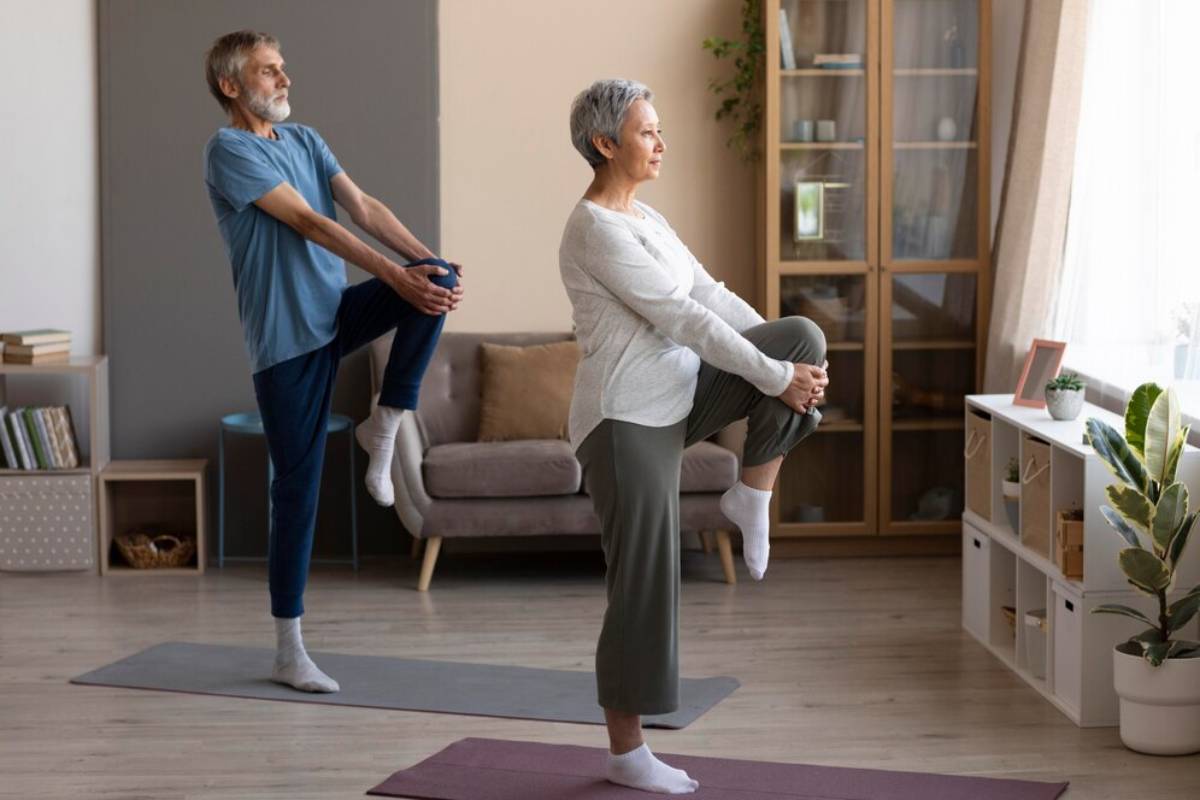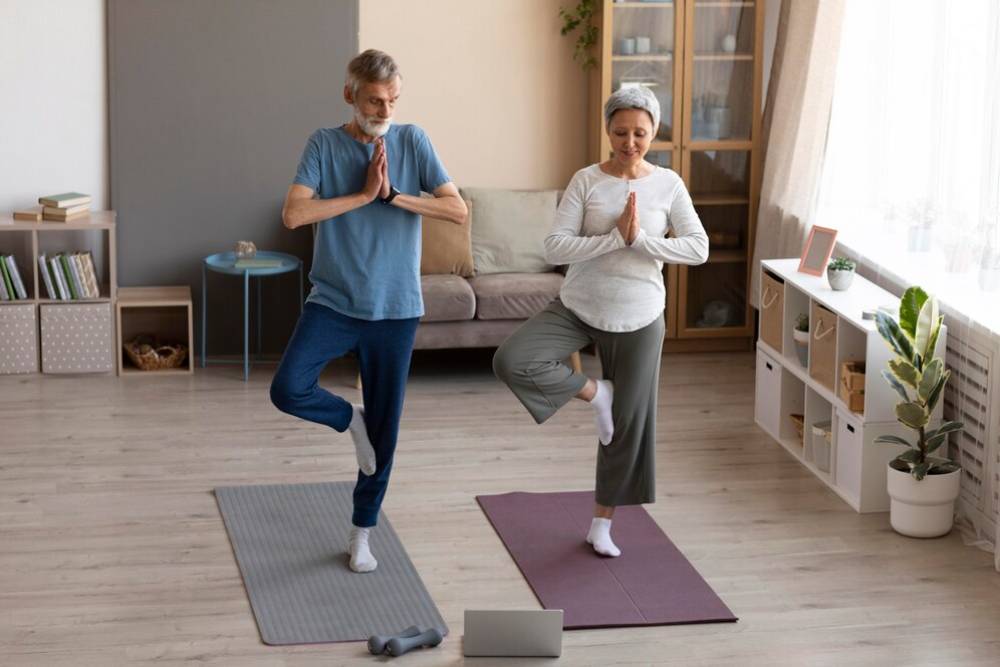
The Importance of Balance Exercises in Aging
As we age, keeping our physical health is vital. Balance exercises are especially important for seniors. They help prevent falls and improve mobility and quality of life. In this blog, we’ll look at why balance training matters for seniors. We’ll explore how it helps prevent falls and boosts mobility. We’ll also give tips on adding these exercises to your daily routine. This will help you lead a healthier, more active life.
Key Benefits of Balance Exercises for Seniors
Why It Matters
Balance exercises are crucial for seniors for several reasons. First and foremost, they play a pivotal role in fall prevention. The NHS says that falls are the leading cause of injury deaths for people over 65. Regular balance training helps seniors lower their risk of falling. This can prevent injuries and hospital visits.
Moreover, balance exercises contribute to improved senior mobility. As we age, our muscles naturally weaken, and our coordination diminishes. Regular balance training helps fight these changes. It strengthens muscles and improves neuromuscular coordination. This boost in mobility helps seniors do daily activities more easily and confidently.
Additionally, balance exercises promote better posture and alignment. Poor posture can lead to chronic pain, discomfort, and an increased risk of falls. Seniors can boost their posture by practising balance training. This leads to a steadier and more confident walk.
Real-Life Applications
Consider the case of Margaret, a 70-year-old retiree who struggled with mobility issues. After incorporating balance exercises into her routine, Margaret experienced a remarkable transformation. She felt more stable. Now, she can enjoy gardening and walking her dog without worrying about falling. Her story is a testament to the profound impact that balance training can have on a senior’s life.
John, a retired teacher, began to avoid stairs and outdoor activities because he was worried about his balance. He worked with a physical therapist and added balance exercises to his routine. Then, he regained confidence and began to enjoy long walks again. Real-life examples show that balance training can greatly enhance seniors’ quality of life.
Step-by-Step Guide to Balance Training
Getting Started with Balance Exercises
Before starting any exercises, talk to a healthcare professional. This ensures the activities are safe and proper for you. Once given the green light, seniors can begin their balance training journey.
Basic Balance Exercises

- Standing on One Leg: This simple exercise can be performed anywhere. Stand next to a sturdy chair or table for support. Lift one leg off the ground and hold the position for 10-15 seconds. Repeat with the other leg. This exercise helps improve balance and strengthens the muscles in the legs.
- Heel-to-Toe Walk: This exercise enhances coordination. Walk in a straight line, placing the heel of one foot directly in front of the toes of the other foot. Focus on maintaining a steady pace and balance.
- Tai Chi: This ancient Chinese martial art is renowned for its balance-enhancing properties. It consists of slow and gentle movements, and it helps enhance flexibility, strength, and balance.
- Side Leg Raises: Stand straight and lift one leg to the side while keeping your back straight. Hold for a few seconds and lower the leg back down. Repeat with the other leg.
- Back Leg Raises: Similar to side leg raises, but this time, extend the leg backwards instead. This helps strengthen the glutes and improve balance.
Advanced Balance Exercises

- Single-Leg Squats: Stand on one leg and slowly lower yourself into a squat position. This exercise builds strength and balance. It’s perfect for anyone who wants a challenge.
- Yoga: Many yoga poses, such as the Tree Pose or Warrior III, focus on balance and stability. Regular practice can lead to significant improvements in balance and flexibility.
- Bosu Ball Exercises: A Bosu ball creates instability during workouts. This challenges your body and makes your core muscles work harder to stay balanced. This advanced tool is excellent for those seeking to elevate their balance training.
- Step-Ups: Using a sturdy step or platform, step up and down with control, alternating legs. This improves balance and strength in the lower body.
- Resistance Band Training: Using a resistance band for balance exercises improves core strength and stability.
Additional Expert Tips & Common Mistakes to Avoid
Best Practices

- Start Slow: Begin with simple exercises. Then, slowly move to more advanced routines. This approach helps prevent injuries and builds confidence.
- Practice Regularly: To gain the benefits of balance training, you must practice often. Aim for at least three sessions per week.
- Mixing up exercises makes workouts fun. It also targets different muscle groups.
- Use Support if Needed: Holding onto a chair or wall can help while starting out. Gradually reduce reliance on support as balance improves.
- Stay Hydrated and Nourished: Drink plenty of water and eat healthy. This helps your muscles and joints function better.
Common Mistakes
- Neglecting Warm-Up: Always warm up first. This prepares your muscles and joints for exercise.
- Stop any exercise that causes pain. Then, talk to a healthcare professional.
- Overconfidence: Avoid attempting advanced exercises without mastering the basics. Overconfidence can lead to injuries.
- Skipping Core Strengthening: A strong core is crucial for balance. Incorporating core exercises can further enhance stability.
Advanced Insights and Expert Recommendations
Unique Industry Perspectives
Recent studies have highlighted the cognitive benefits of balance exercises. Engaging in activities that challenge balance also stimulates the brain, enhancing cognitive function. Balance training offers two key advantages, making it essential for senior health.
Additionally, balance exercises have been linked to improved mental well-being. Mastering new balance skills feels excellent. It boosts confidence and helps ease anxiety about moving.
Lesser-Known Insights
Balance exercises can boost proprioception, which means they help the body know its position in space. This heightened awareness contributes to better coordination and a reduced risk of falls.
Balance exercises can improve joint health. They promote better weight distribution and reduce strain on joints. Seniors with arthritis or joint pain can benefit significantly from balance exercises in their routines.
Conclusion: Embracing a Balanced Future
Balance exercises are the cornerstone of senior fitness. They offer a treasure trove of benefits extending far beyond fall prevention. By honing balance, seniors can elevate their mobility and boost their confidence, enhancing their overall quality of life. As we age, balance is more than just being steady. It’s about enjoying an active lifestyle.
A steady balance routine unlocks a suite of long-term perks. They include better coordination, improved posture, sharper brain function, and more independence. Small, steady strides in balance can profoundly affect daily life. Imagine effortlessly climbing stairs or engaging in playful antics with grandchildren.
So, why wait for tomorrow? Begin your journey towards a balanced future today whether it’s Tai Chi, yoga, or simple leg lifts, the secret lies in consistency and commitment. A more potent, steadier, and more confident you is just around the corner!